Complete Solutions to Exercises Single Correct of chapter MAGNETIC FIELD AND MAGNETIC FORCES of Class 12 book with complete answers and questions
| Class 12 | PHYSICS |
| Chapter | MAGNETIC FIELD AND MAGNETIC FORCES |
| CENGAGE PHYSICS | Exercises Single Correct |
| Number Of Questions | 70 |
| Academic Year | 2023-24 |
A neutron, a proton, an electron and an `alpha-`particle enter a region of uniform magnetic field with equal velocities. The magnetic field is perpendicular to the paper and directed into it. The tracks of particles are labeled in Fig. 1.132. The neutron follows the track
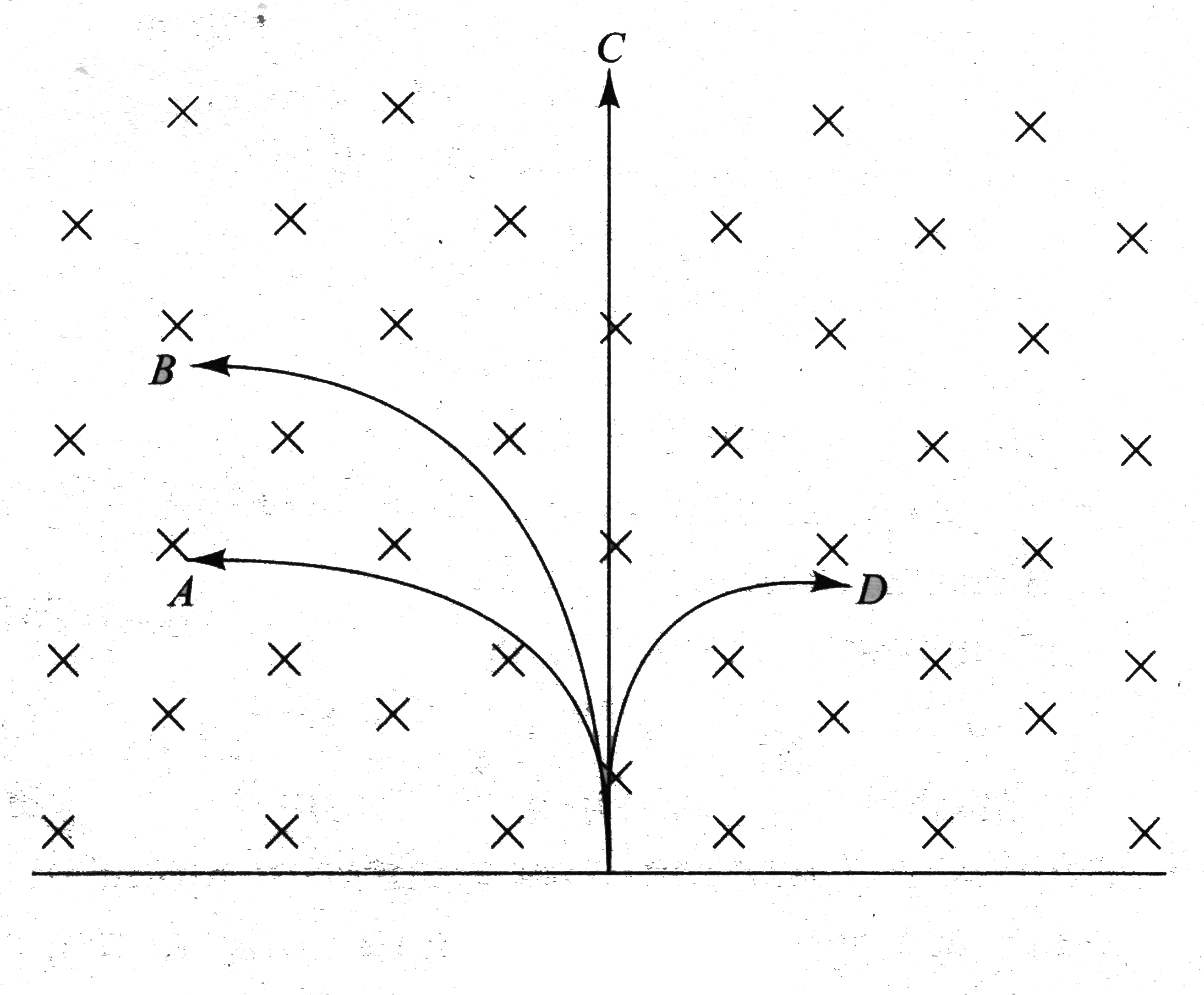 01:33View Solution
01:33View SolutionA U tube of uniform square cross-sectional side a has mercury in it. Current I is passed between sealed electrodes x and y. A magnetic field `B` is applied across horizontal section perpendicular to the plane of diagram. The difference in mercury levels is [Given: `rho` = density of mercury]
 .01:14View Solution
.01:14View SolutionAn electron accelerated through a potential difference V passes through a uniform transverse magnetic field and experiences a force F. If the accelerating potential is increased to 2V, the electron in the same field will experience a force
01:58View SolutionAn electron is moving along positive x-axis. To get it moving on an anticlockwise circular path in x-y plane, a magnetic field is applied
02:15View SolutionTwo particles X and Y having equal charges, after being accelerated through the same potential difference, enter a region of uniform magnetic field and describe circular paths of radii `R_1 and R_2,` respectively. The ratio of masses of X and Y is
02:11View SolutionAn electron of mass `0.90 xx 10^(-30)` kg under the action of a magnetic field moves in a circle of 2.0 cm radius at a speed `3.0 xx 10^6 ms^-1`. If a proton of mass `1.8 xx 10^(-27) kg` was to move in a circle of the same radius in the same magnetic field, then its speed will be
02:33View SolutionA charged particle of mass `10^-3 kg` and charge `10^-5 C` enters a magnetic field of induction 1 T. If `g = 10 ms^-2,` for what value of velocity will it pass straight through the field without deflection?
01:19View SolutionA particle of mass `2 xx 10^-5 kg` moves horizontally between two horizontal plates of a charged parallel plate capacitor between which there is an electric field of `200 NC^-1` acting upward. A magnetic induction of 2.0 T is applied at right angles to the electric field in a direction normal to both `vec B and vec v.` If g is `9.8 ms^-2` and the charge on the particle is `10^-6 C,` then find the velocity of charge particle so that it continues to move horizontally
04:04View SolutionA charged particle moves along a circle under the action of passible constant electric and magnetic fields. Which of the following are possible?
01:50View SolutionTwo particles Y and Z emitted by a radioactive source at P made tracks in a chamber as illustrated in the Fig. 1.134. A magnetic field acts downward into the paper. Careful measurements showed that both tracks were circular, the radius of Y track being half that of the Z track. Which one of the following statements is certainly true?
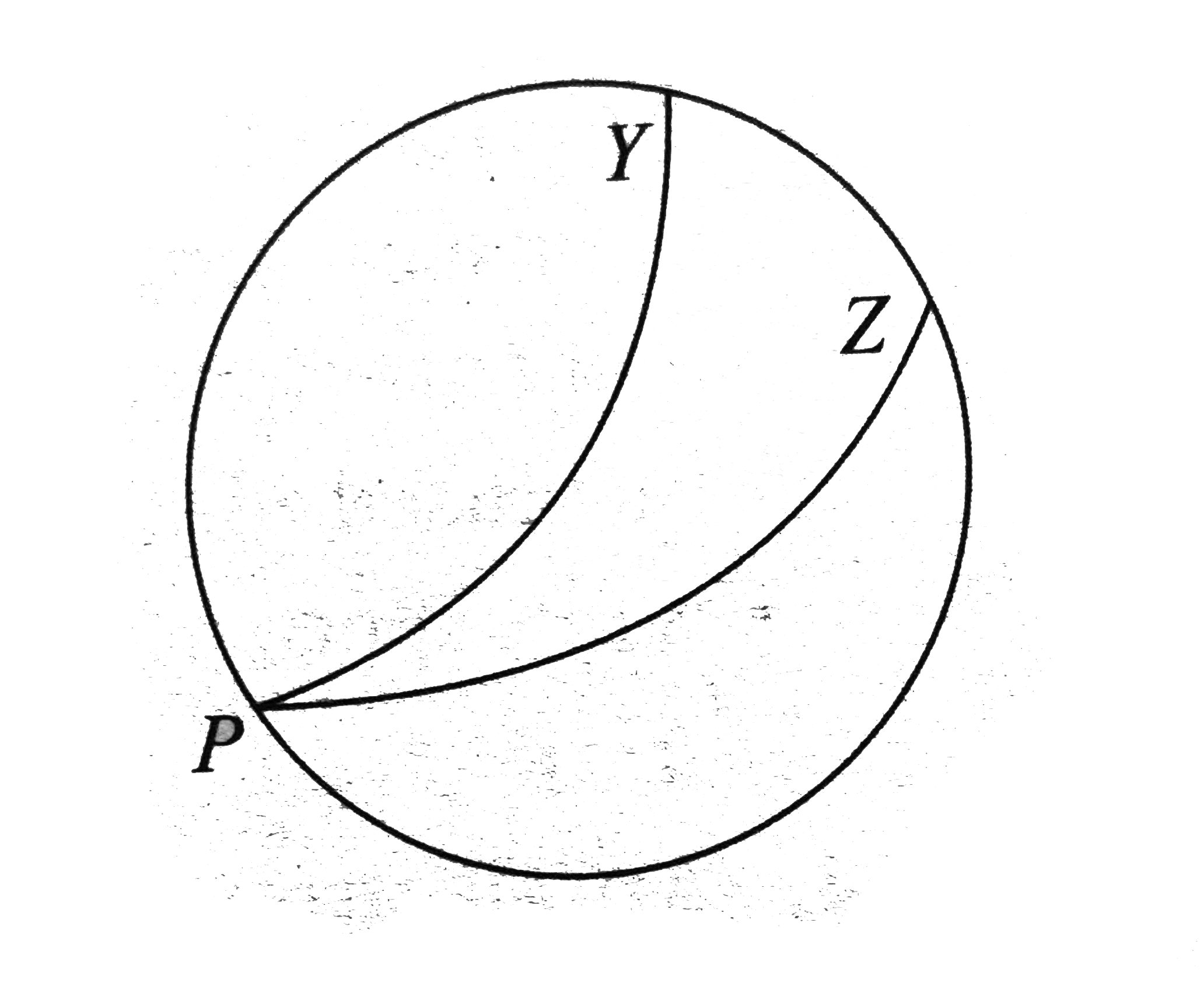 03:17View Solution
03:17View SolutionA proton and an `alpha-`particle enter a uniform magnetic field moving with the same speed. If the proton takes `25 mu s` to make 5 revolutions, then the periodic time for the `alpha-` particle would be
02:32View SolutionAn electron is launched with velocity `vec v` in a uniform magnetic field `vec B.` The angle `theta` between `vec v and vec B` lies between 0 and `pi /2`. Its velocity vector `vec v` returns to its initial value in a time interval of
01:05View SolutionA charged particle is whirled in a horizontal circle on a frictionless table by attaching it to a string fixed at one pint. If a magnetic field is wsitched on in the vertical direction, the tension in the string
02:20View SolutionA charged particle moves with velocity `vec v = a hat i + d hat j` in a magnetic field `vec B = A hat i + D hat j.` The force acting on the particle has magnitude F. Then,
01:27View SolutionA particle with a specific charge s is fired with a speed v toward a wall at a distance d, perpendicular to the wall. What minimum magnetic field must exist in this region for the particle not to hit the wall?
01:46View SolutionA charged particle begins to move from the origin in a region which has a uniform magnetic field in the x-direction and a uniform electric field in the y-direction. Its speed is v when it reaches the point (x, y, z). Then, v will depend
02:30View SolutionTwo metal strips of length l each are placed parallel to each other in contact with an electric circuit as shown in Fig. 1.135. The entire structure is placed on a smooth horizontal floor in a region in which magnetic field is existing in vertical direction.
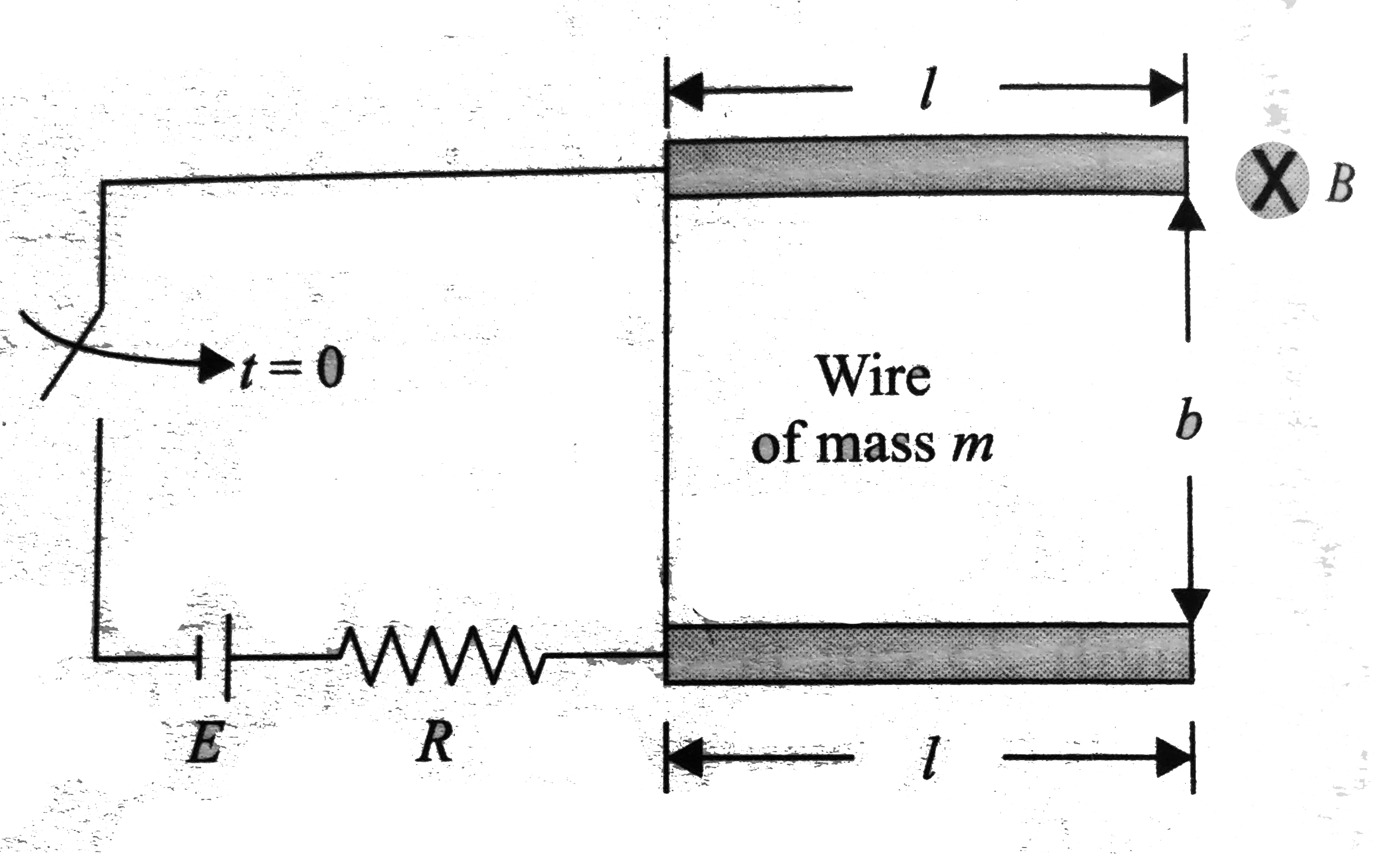
The distance travelled by the wire as a function of time is best given by
where `t_0 = sqrt ((2lmR)/(EBb))`02:41View SolutionA particle of charge q and mass m is projected with a velocity `v_0` toward a circular region having uniform magnetic field B perpendicular and into the plane of paper from point P as shown in Fig. 1.136. R is the radius and O is the center of the circular region. If the line OP makes an angle `theta` with the direction of `v_0` then the value of `v_0` so that particle passes through O is
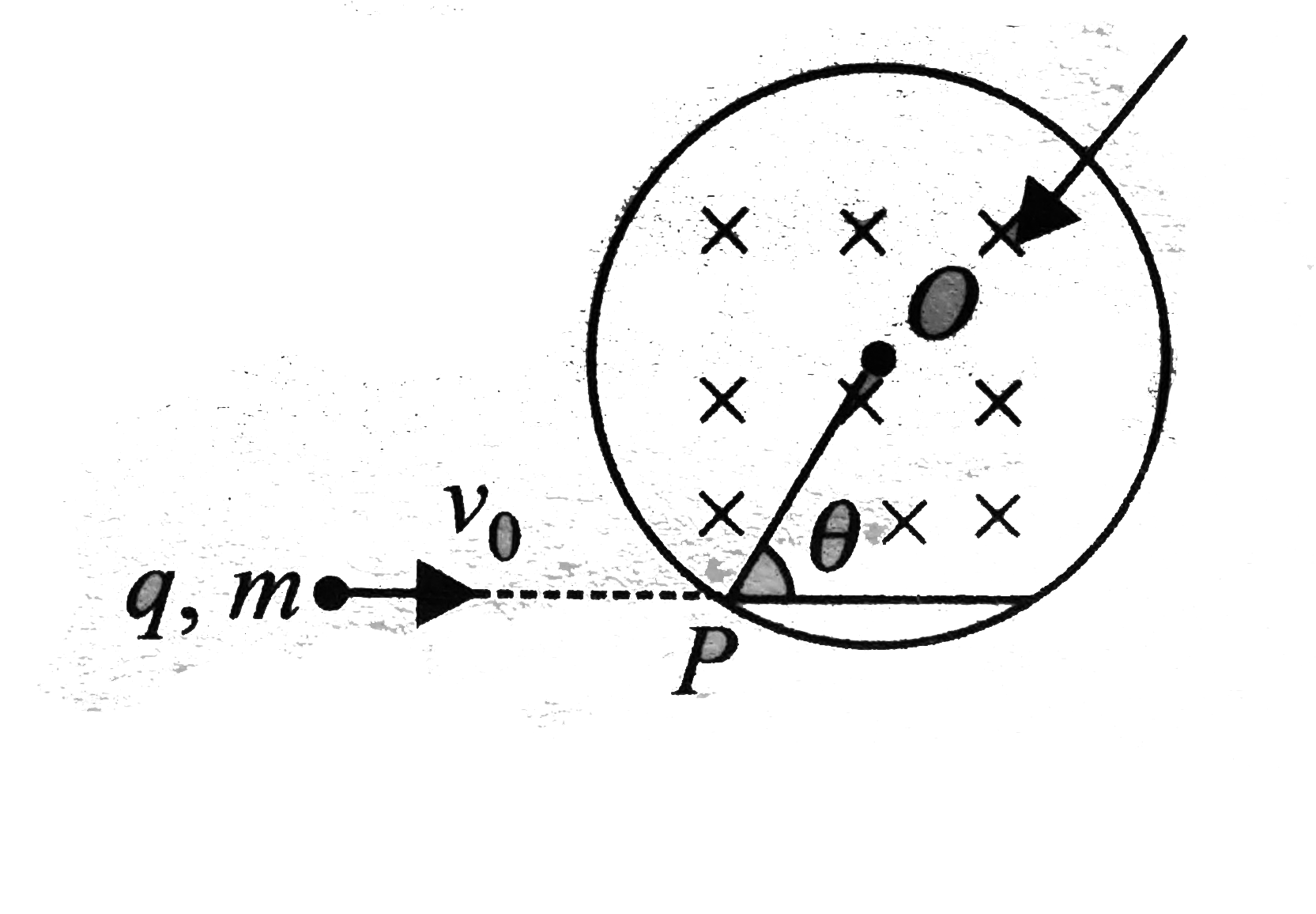 02:14View Solution
02:14View SolutionAn electron moving with a speed u along the positive x-axis at `y=0` enters a region of uniform magnetic field which exists to the right of y-axis. The electron exits from the region after some time with the speed v at coordinate y, then
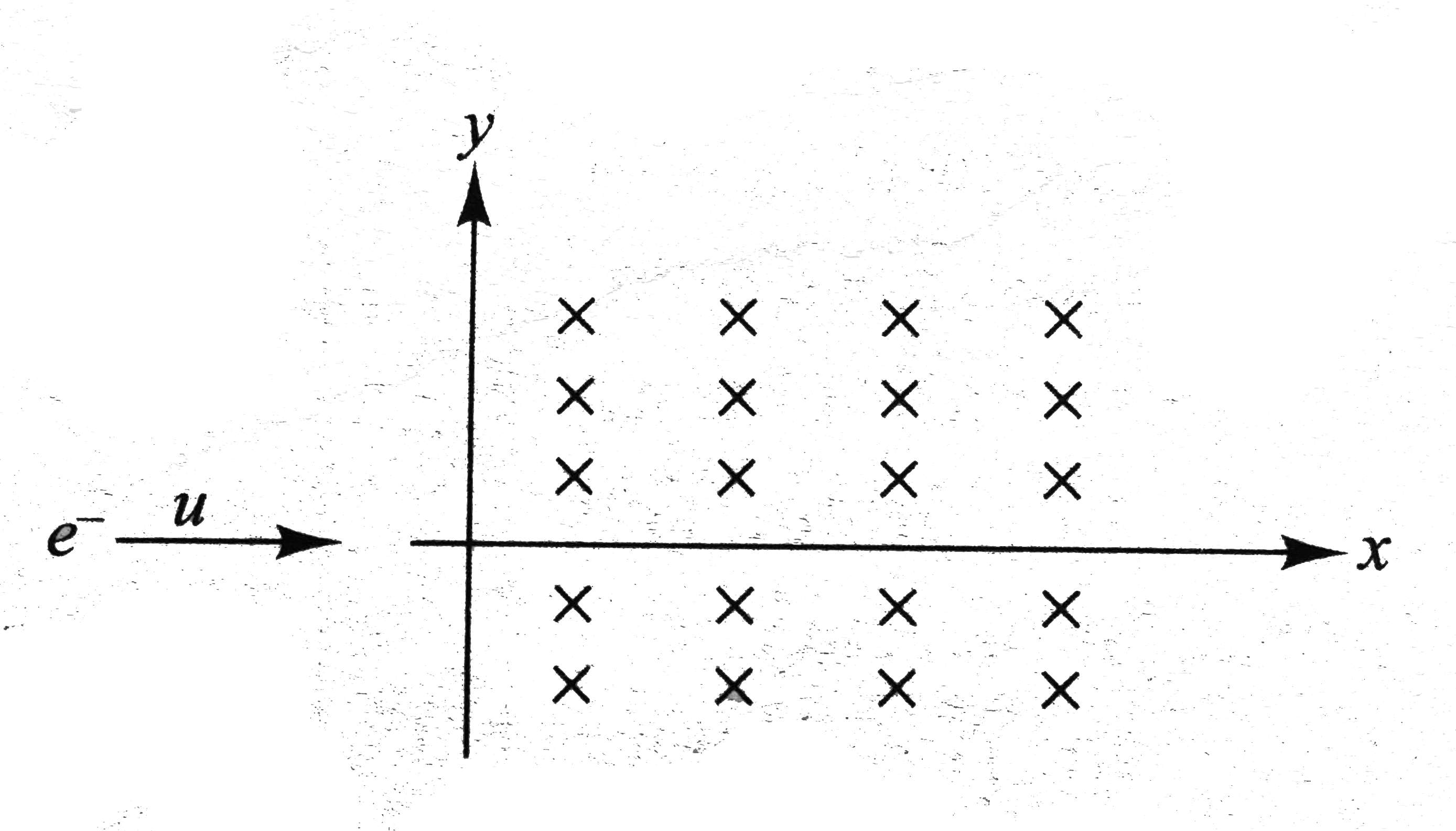 01:00View Solution
01:00View SolutionAn electron is accelerated from rest through a potential difference V. This electron experiences a force F in a uniform magnetic field. On increasing the potential difference to V', the force experienced by the electron in the same magnetic field becomes 2F. Then, the ratio `(V'//V)` is equal to
03:28View SolutionA particle of charge q and mass m starts moving from the origin under the action of an electric field `vec E = E_0 hat i and vec B = B_0 hat i` with a velocity `vec v = v_0 hat j`. The speed of the particle will become `2v_0` after a time.
08:40View SolutionA conducting rod of mass m and length l is placed over a smooth horizontal surface. A uniform magnetic field B is acting perpendicular to the rod. Charge q is suddenly passed through the rod and it acquires an initial velocity v on the surface, then q is equal to
02:45View SolutionA particle of charge per unit mass `alpha` is released from origin with velocity `vec v = v_0 hat i` in a magnetic field
`vec B = -B_0 hat k` for `x le sqrt 3/2 v_0/(B_0 alpha)`
and `vec B = 0` for `x gt sqrt 3/2 v_0/(B_0 alpha)`
The x-coordinate of the particle at time `t(gt pi/(3B_0 alpha))` would be07:26View SolutionLet current `i=2A` be flowing in each part of a wire frame as shown in Fig. 1.138. The frame is a combination of two equilateral triangles ACD and CDE of side 1 m. It is placed in uniform magnetic field ` B= 4 T` acting perpendicular to the plane of frame. The magnitude of magnetic force acting on the frame is
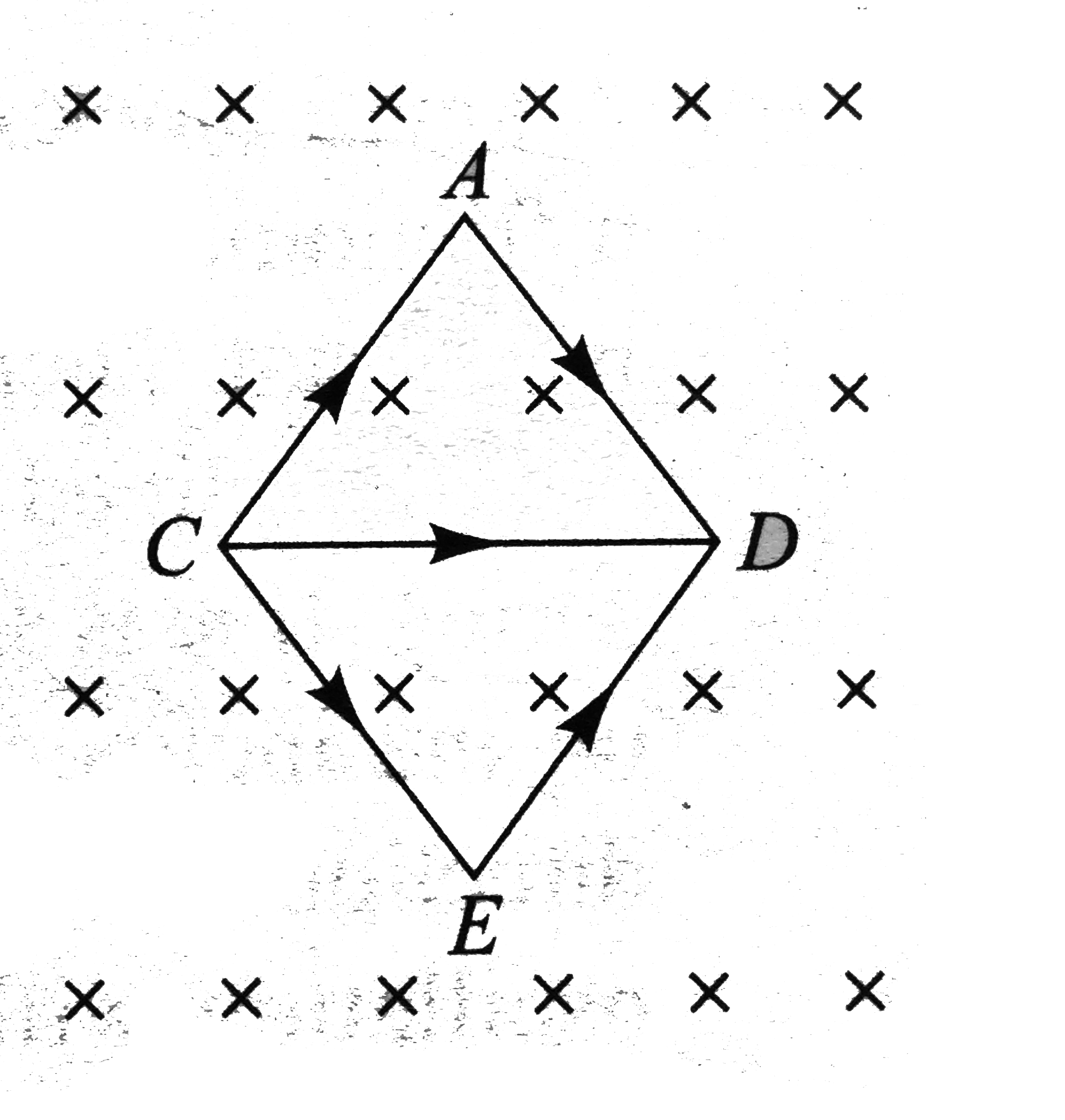
The pithc of the helical path followed by the particle is p. The radius of the helix will be03:42View SolutionA charged particle enters a uniform magnetic field with velocity vector at angle of `45^@` with the magnetic field. The pitch of the helical path followed by the particle is p. the radius of the helix will be
02:43View SolutionA charged particle of specific charge (charge/mass) `alpha` released from origin at time `t=0` with velocity `vec v = v_0 (hat i + hat j)` in uniform magnetic field `vec B = B_0 hat i.` Coordinates of the particle at time `t= pi//(B_0 alpha)` are
04:30View SolutionTwo identical particles having the same mass m and charges +q and -q separated by a distance d enter a uniform magnetic field B directed perpendicular to paper inwards with speeds `v_1 and v_2` as shown in Fig. 1.139. The particles will not collide if
 06:22View Solution
06:22View SolutionThe plane of a rectangular loop of wire with sides 0.05 m and 0.08 m is parallel to a uniform magnetic field of induction `1.5 xx 10^-2 T.` A current of 10.0 ampere flows through the loop. If the side of length 0.08 m is normal and the side of length 0.05 m is parallel to the lines of induction, then the torque acting on the loop is
02:53View SolutionA loop of flexible conducting wire of length l lies in magnetic field B which is normal to the plane of loop. A current l is passed through the loop. The tension developed in the wire to open up is
04:03View SolutionA conducting rod of length l and mass m is moving down a smooth inclined plane of inclination `theta` with constant i is flowing in the conductor in a direction perpendicular to paper inwards. A vertically upward magnetic field `vec B` exists in space. Then, magnitude of magnetic field `vec B` is
 02:21View Solution
02:21View SolutionA square loop of wire carrying current I is lying in the plane of paper as shown in Fig. 1.141. The magnetic field is present in the region as shown. The loop will tend to rotate
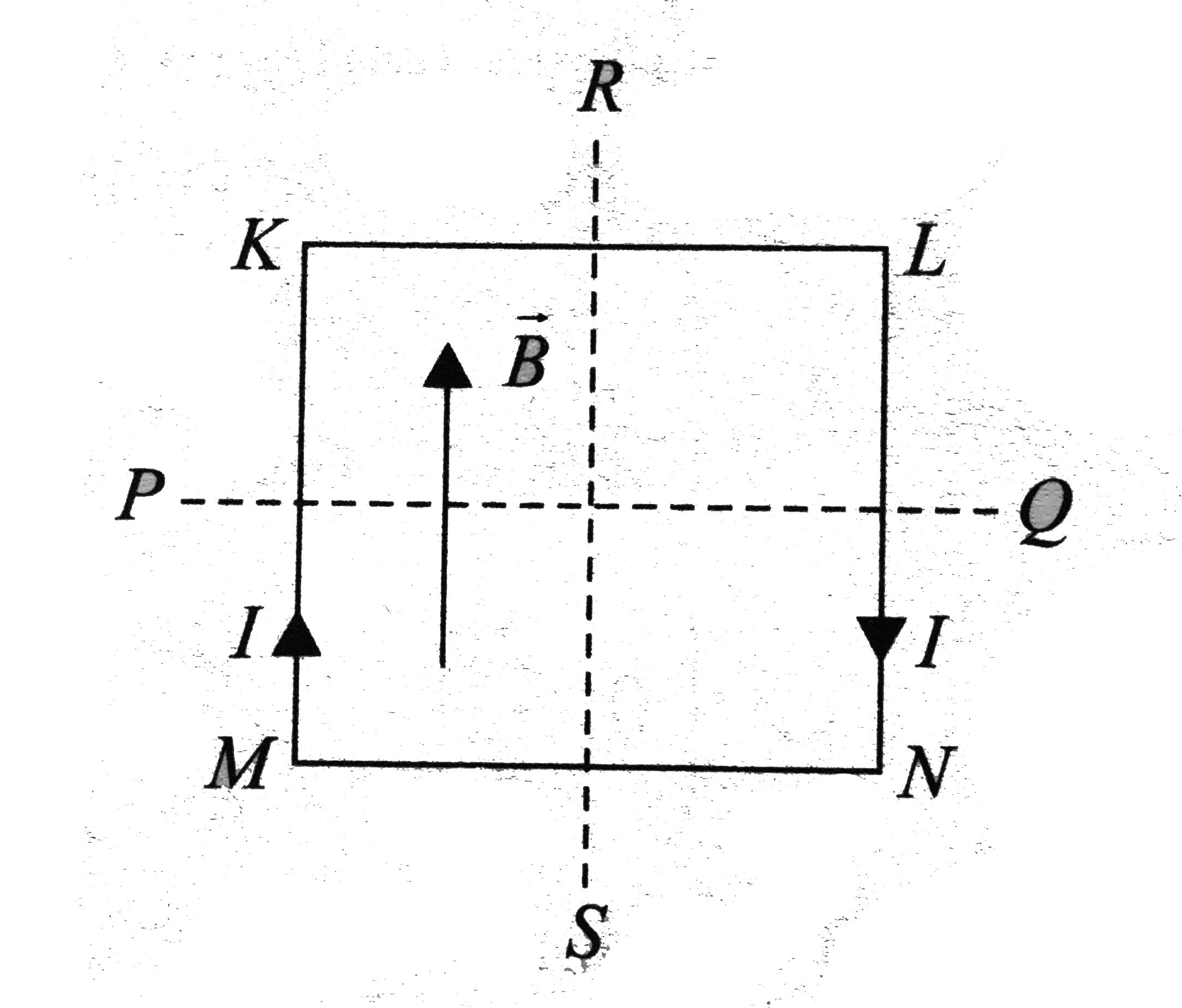 01:56View Solution
01:56View SolutionA uniform current carrying ring of mass `m` and radius `R` is connected by a massless string as shown in Fig. 1.142. A uniform magnetic field `B_0` exists in the region to keep the ring in horizontal position, then the current in the ring is (l=length of string)
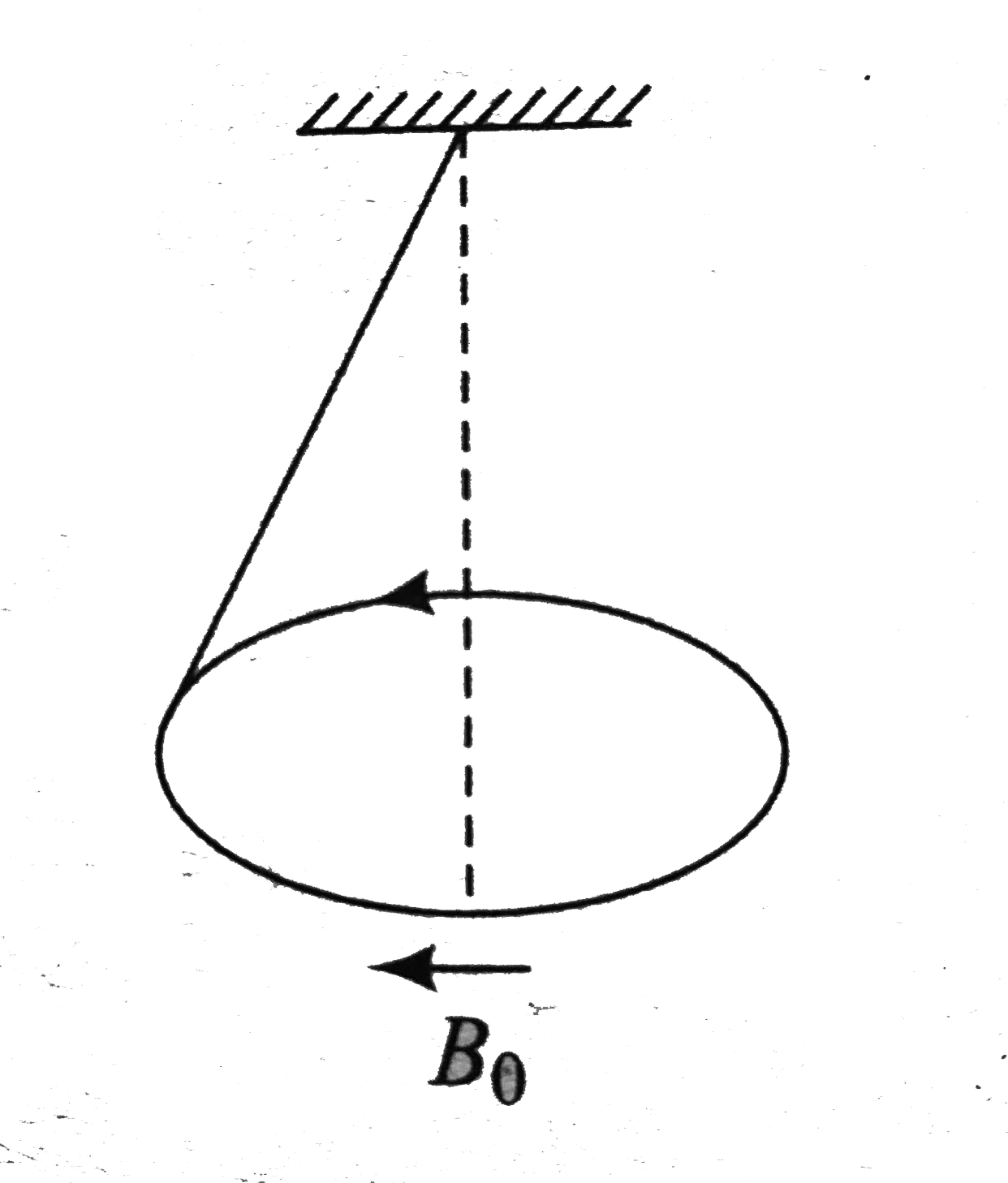 .03:22View Solution
.03:22View SolutionA circular coil having mass m is kept above ground (x-z plane) at some height. The coil carries i in the direction shown in Fig. 1.143. In which direction a uniform magnetic field `vec B` be applied so that the magnetic force balances the weight of the coil?
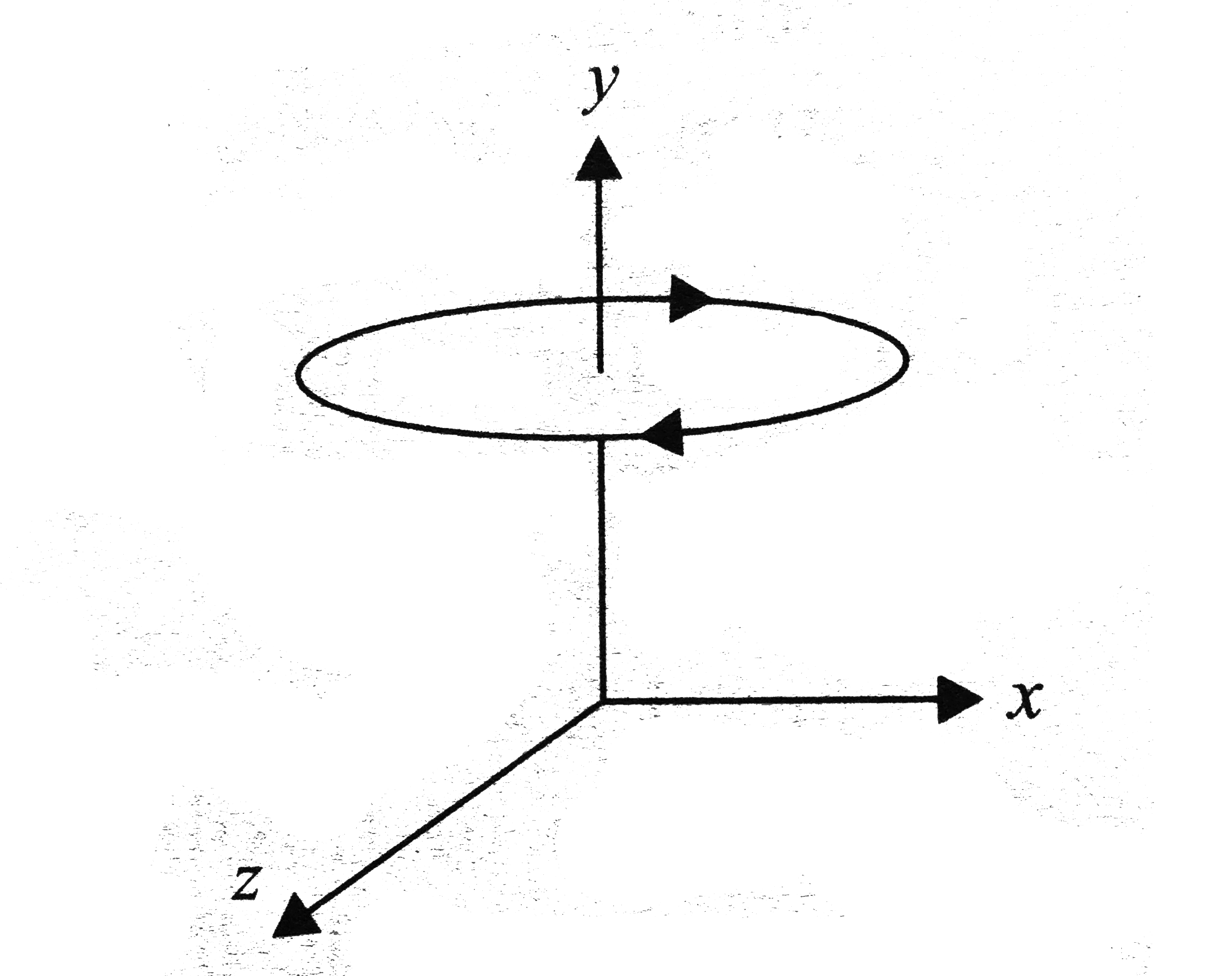 02:07View Solution
02:07View SolutionA charged particle moving along +ve x-direction with a velocity v enters a region where there is a uniform magnetic field `B_0(-hat k), from x=0 to x=d.` The particle gets deflected at an angle `theta` from its initial path. The specific charge of the particle is
 02:16View Solution
02:16View SolutionIn Fig. a coil of single turn is wound on a sphere of radius r and mass m. The plane of the coil is parallel to the inclined plane and lies in the equatorial plane of the sphere. If the sphere is in rotational equilibrium, the value of B is [Current in the coil is i]
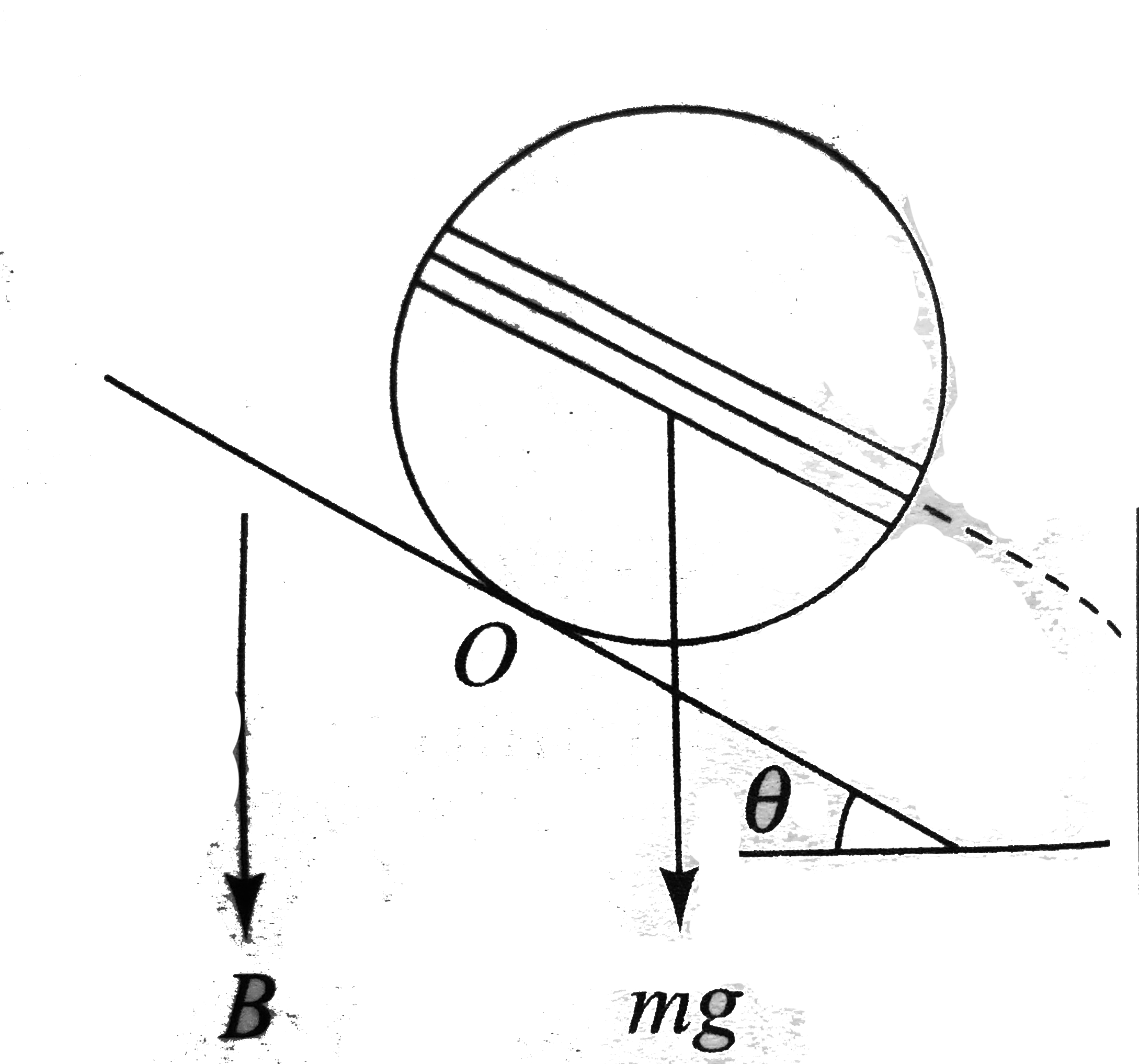 03:30View Solution
03:30View SolutionThree paticles, an electron (e), a proton (p) and a helium atom (He) are moving in circular paths with constant speeds in the x-y plane in a region where a uniform magnetic field B exists along z-axis. The times taken by e, p and He inside the field to complete one revolution are `t_e, t_p and t_He` respectively. Then,
01:53View SolutionThe rigid conducting thin wire frame carries an electric current I and this frame is inside a uniform magnetic field `vec B` as shown in Fig. 1.146. Then,
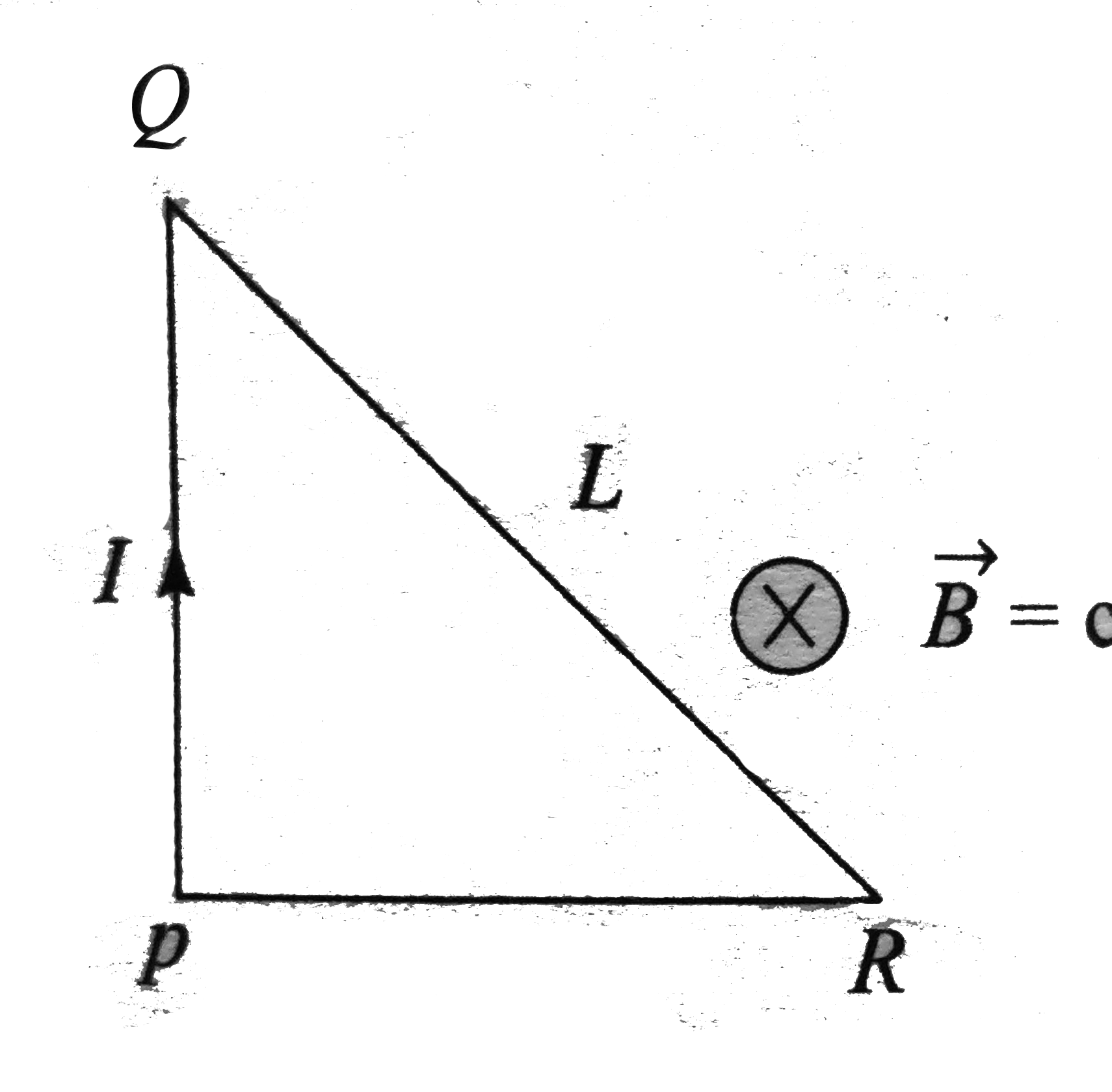 01:44View Solution
01:44View SolutionFigure. shows a conducting loop ABCDA placed in a uniform magnetic field (strength B) perpendicular to its plane. The part ABC is the (three-fourth) portion of the square of side length l. The part ADC is a circular arc of radius R. The points A and C are connected to a battery which supplies a current I to the circuit. The magnetic force on the loop due to the field B is
 04:08View Solution
04:08View SolutionA small block of mass m, having charge q, is placed on a frictionless inclined plane making an angle `theta` with the horizontal. There exists a uniform magnetic field B parallel to the inclined plane but perpendicular to the length of spring. If m is slightly pulled on the incline in downward direction, the time period of oscillation will be (assume that the block does not leave contact with the plane)
 01:57View Solution
01:57View SolutionA uniform conducting rectangular loop of sides l, b and mass m carrying current i is hanging horizontally with the help of two vertical strings. There exists a uniform horizontal magnetic field B which is parallel to the longer side of loop. The value of tension which is least is
 04:18View Solution
04:18View SolutionA particle of specific charge `q/m = pi C kg^-1` is projected from the origin toward positive x-axis with a velocity of `10 ms^-1` in a uniform magnetic field `vec B = -2 hat k T.` The velocity `vec v` of particle after time `t=1/12 s` will be (in `ms^-1`)
03:50View SolutionIn Fig. there is a uniform conducting structure in which each small square has side a. The structure is kept in a uniform magnetic field B. Then the magnetic force on the structure will be
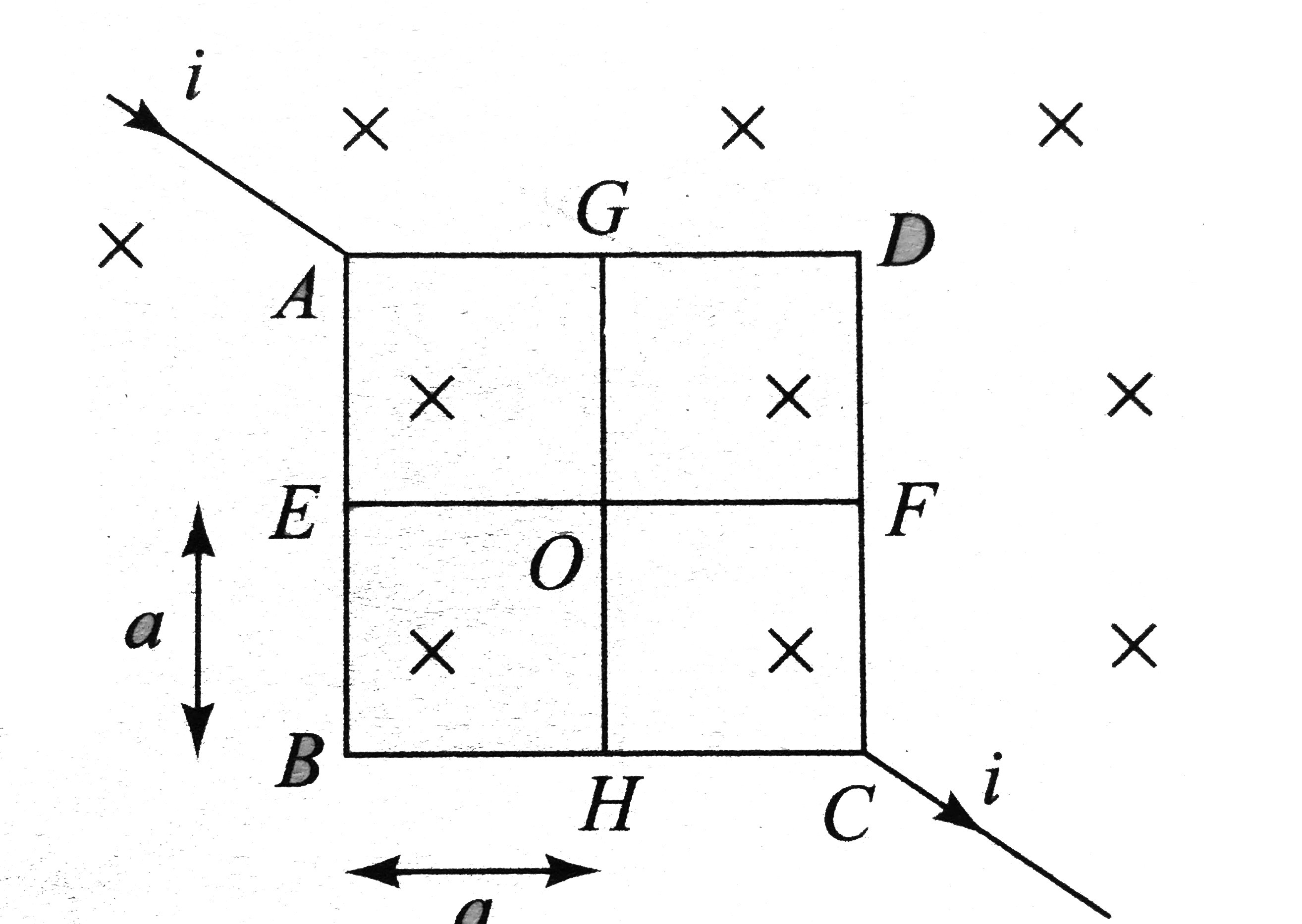 01:56View Solution
01:56View SolutionA charged particle moves insides a pipe which is bent as shown in Fig. 1.151. If `Rlt (mv)/(qB)` , then force exerted by the pipe on charged particle at P is (Neglect gravity)
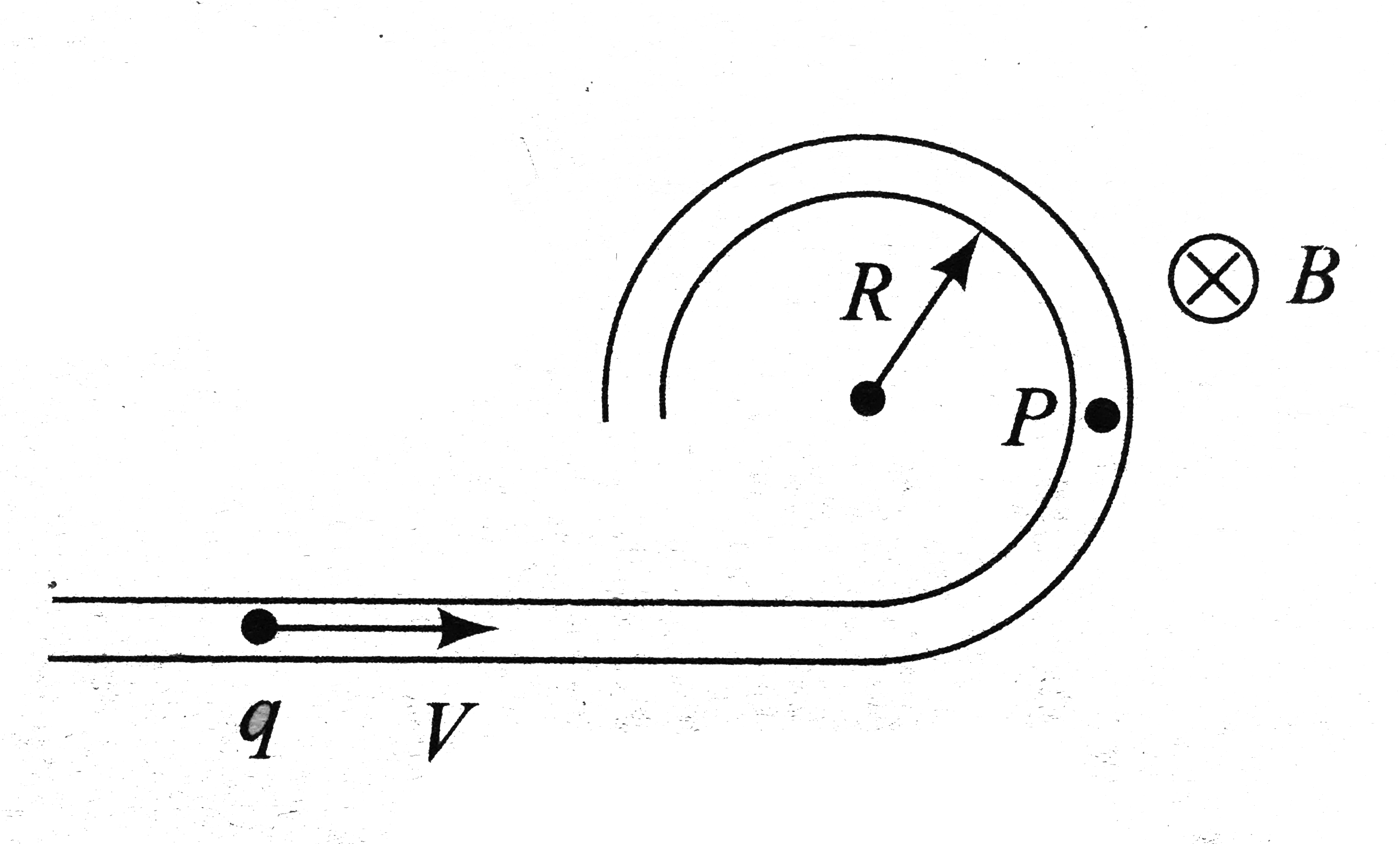 02:17View Solution
02:17View SolutionConsider a hypothetic spherical body. The body is cut into two parts about the diameter. One of hemispherical portion has mass distribution m while the other portion has indentical charge distribution q. The body is rotated about the axis with constant speed `omega.` Then, the ratio of magnetic moment to angular momentum is
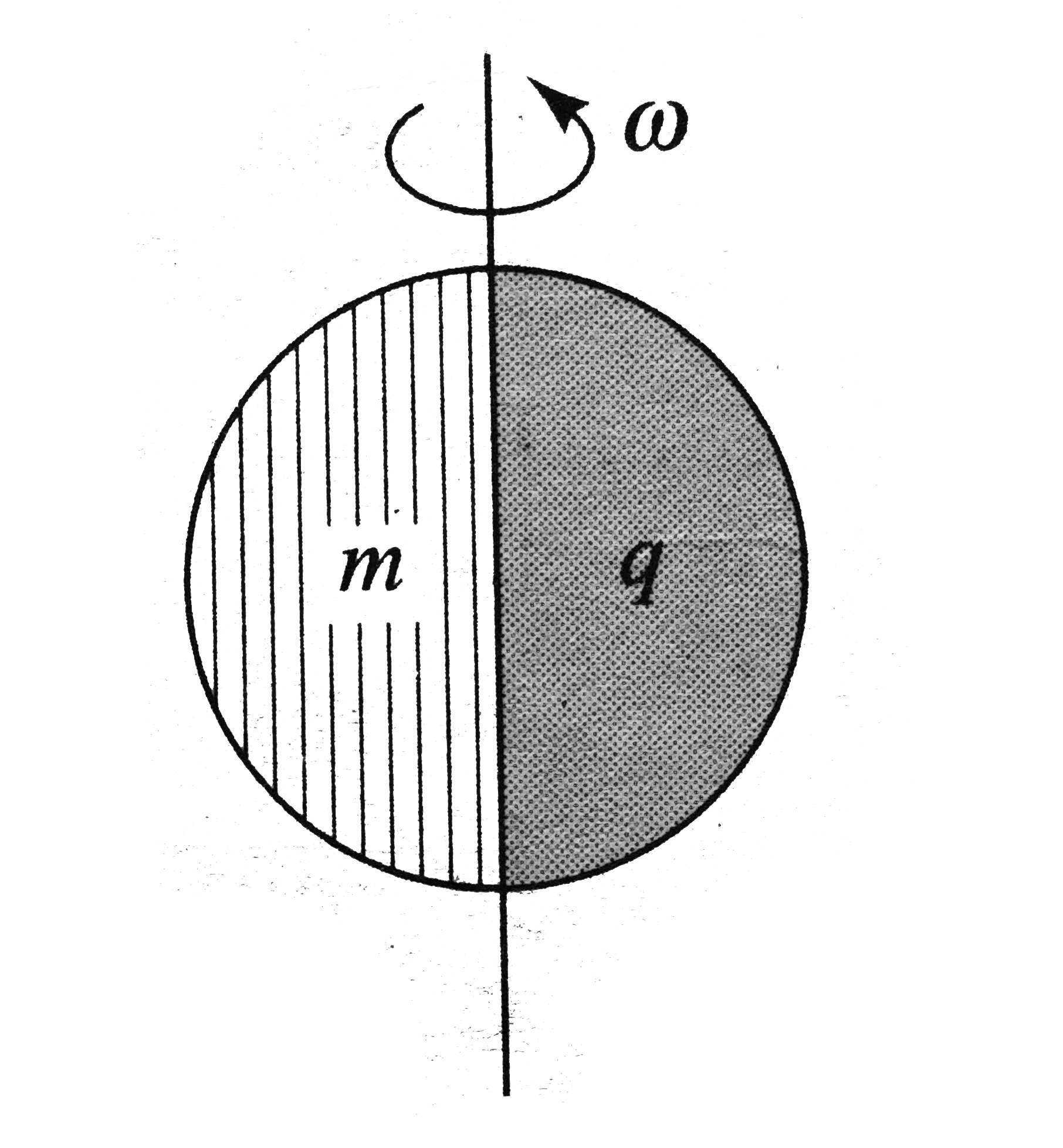 01:31View Solution
01:31View SolutionAn electron and a proton each travel with equal speeds around circular orbits in the same uniform magnetic field as indicated (not to scale) in Fig. The field is into the page on the diagram. The electron travels ____ arount the _____circle.
 01:45View Solution
01:45View SolutionIn a region of space, a uniform magnetic field B exists in the x-direction. An electron is fired from the origin with its initial velocity u making an angle `alpha` with the y direction in the y-z plane. In the subsequent motion of the electron,
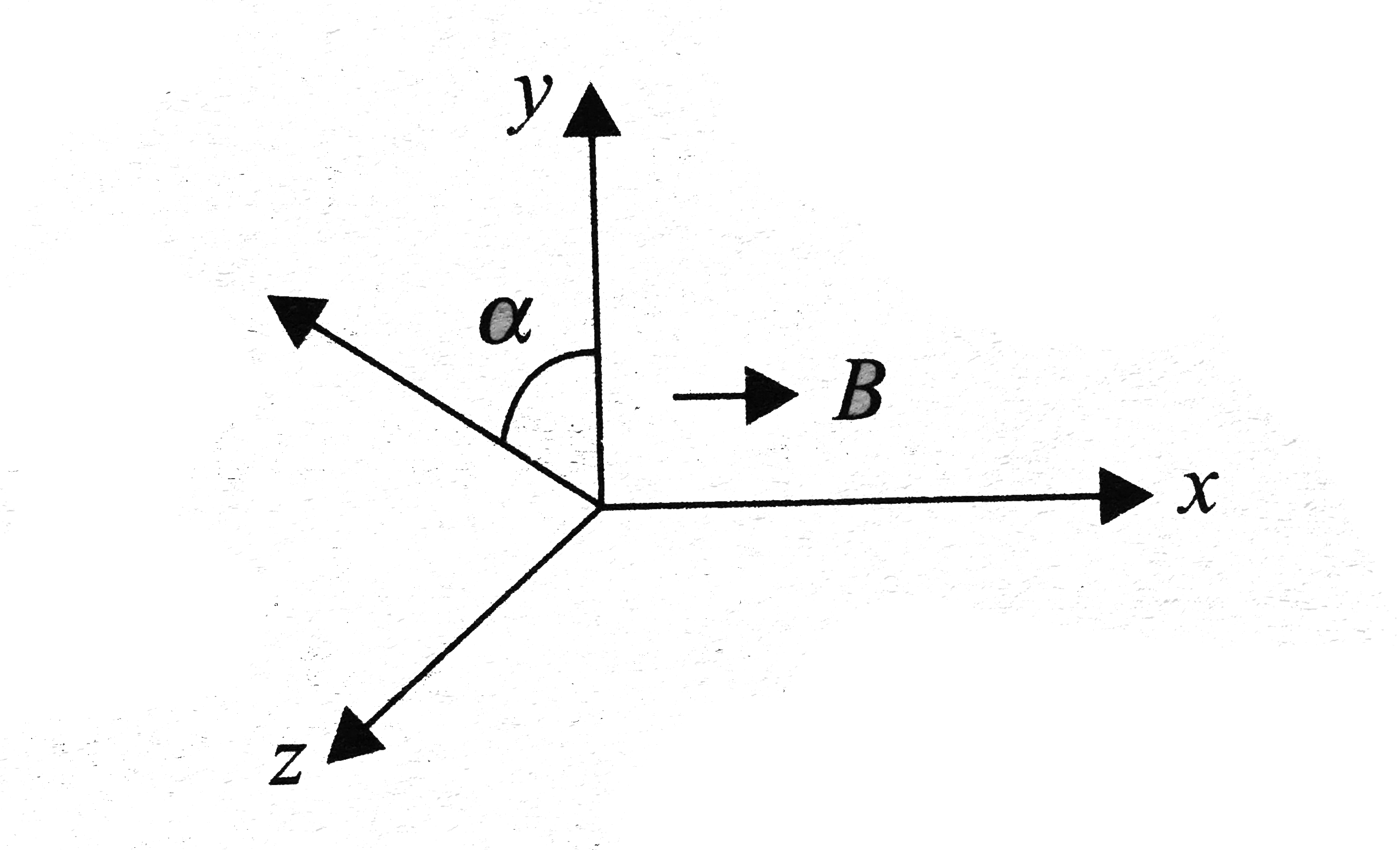 02:34View Solution
02:34View SolutionIf a charged particle of charge to mass ratio `(q/m) = alpha` centers in a magnetic field of strength B at a speed `v=(2 alpha d) (B),` then
 02:45View Solution
02:45View SolutionA conducting ring of mass 2kg and radius `0.5m` is placed on a smooth plane. The ring carries a current of `i=4A`. A horizontal magnetic field `B=10 T` is switched on at time `t=0` as shown in fig The initial angular acceleration of the ring will be
 .03:27View Solution
.03:27View SolutionFigure shows an equilateral triangle ABC of side l carrying currents as shown, and placed in a uniform magnetic field B perpendicular to the plane of triangle. The magnitude of magnetic force on the triangle is
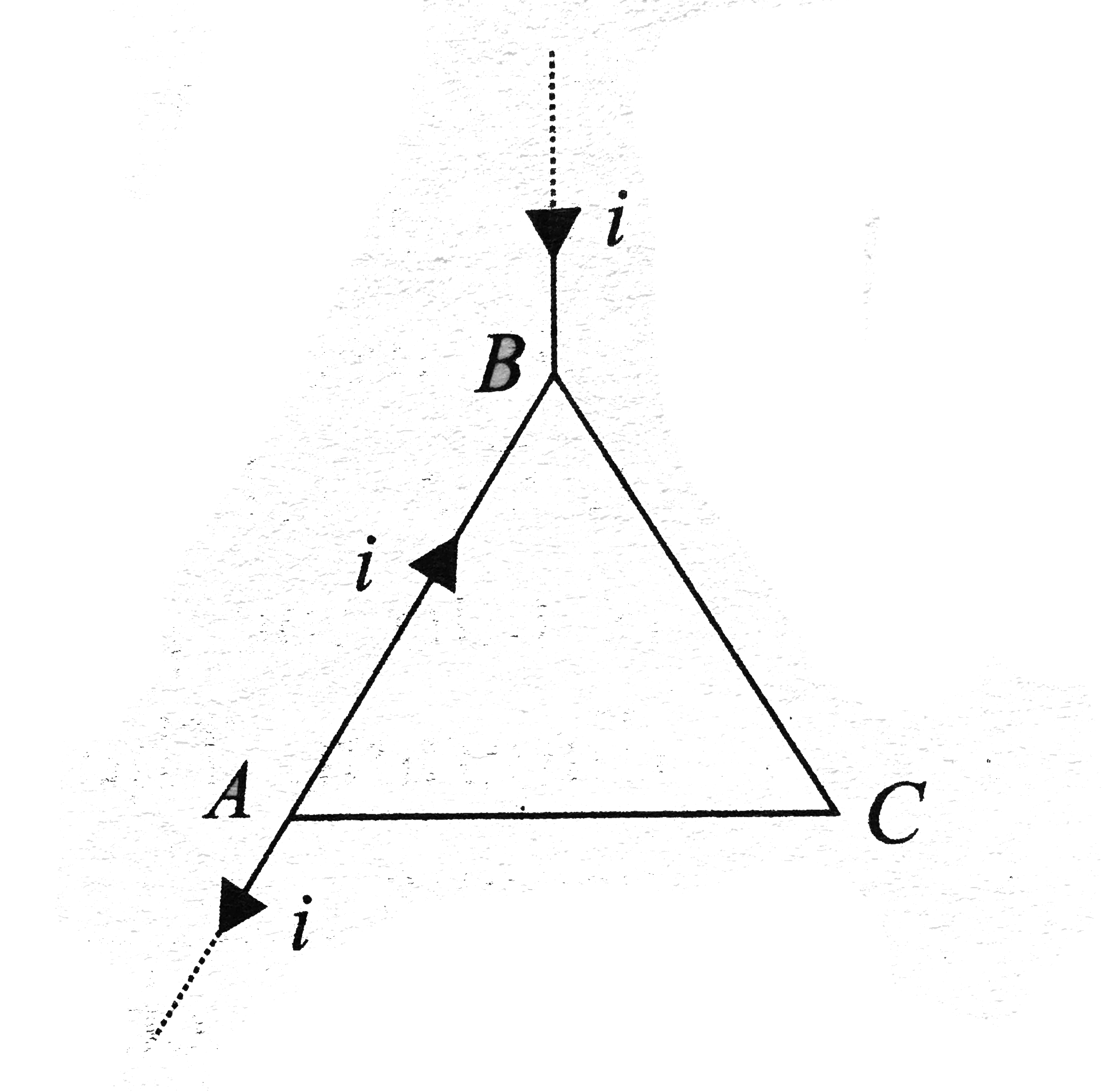 02:44View Solution
02:44View SolutionThere exist uniform magnetic and electric fields of magnitudes 1T and `1Vm^-1` respectively, along positive y-axis. A charged particle of mass 1kg and charge 1C is having velocity `1ms^-1` along x-axis and is at origin at t=0. Then, the coordinates of the particle at time `pis` will be
04:08View SolutionA uniform magnetic field exist in a region which forms an equilateral triangle of side a. The magnetic field is perpendicular to the plane of the triangle . A charged q enters into this magnetic field perpendicular to a side with speed v. The charge enters from midpoint and leaves the field from midpoint of other side. Magnetic induction in the triangles is
02:25View SolutionA particle of positive charge q and mass m enters with velocity `Vhati` at the origin in a magnetic field `B(-hatk)` which is present in the whole space. The charge makes a perfectely inelastic collision with an identical particle (having same charge) ar rest but free to move at its maximum positive y-coordinate. After collision, the combined charge will move on trajectory where `r=(mV)/(qB)`.
04:25View SolutionIn the plane mirror, the coordinates of image of a charged particle (initially at origin as shown in fig. after two and a half time periods are (initial velocity of charge particle `v_0` in the x-y plane and the plane mirror is perpendicular to the x-axis. A uniform magnetic field `Bhati` exists in the space. `P_0` is pitch of helix, `R_0` is raduis of helix.)
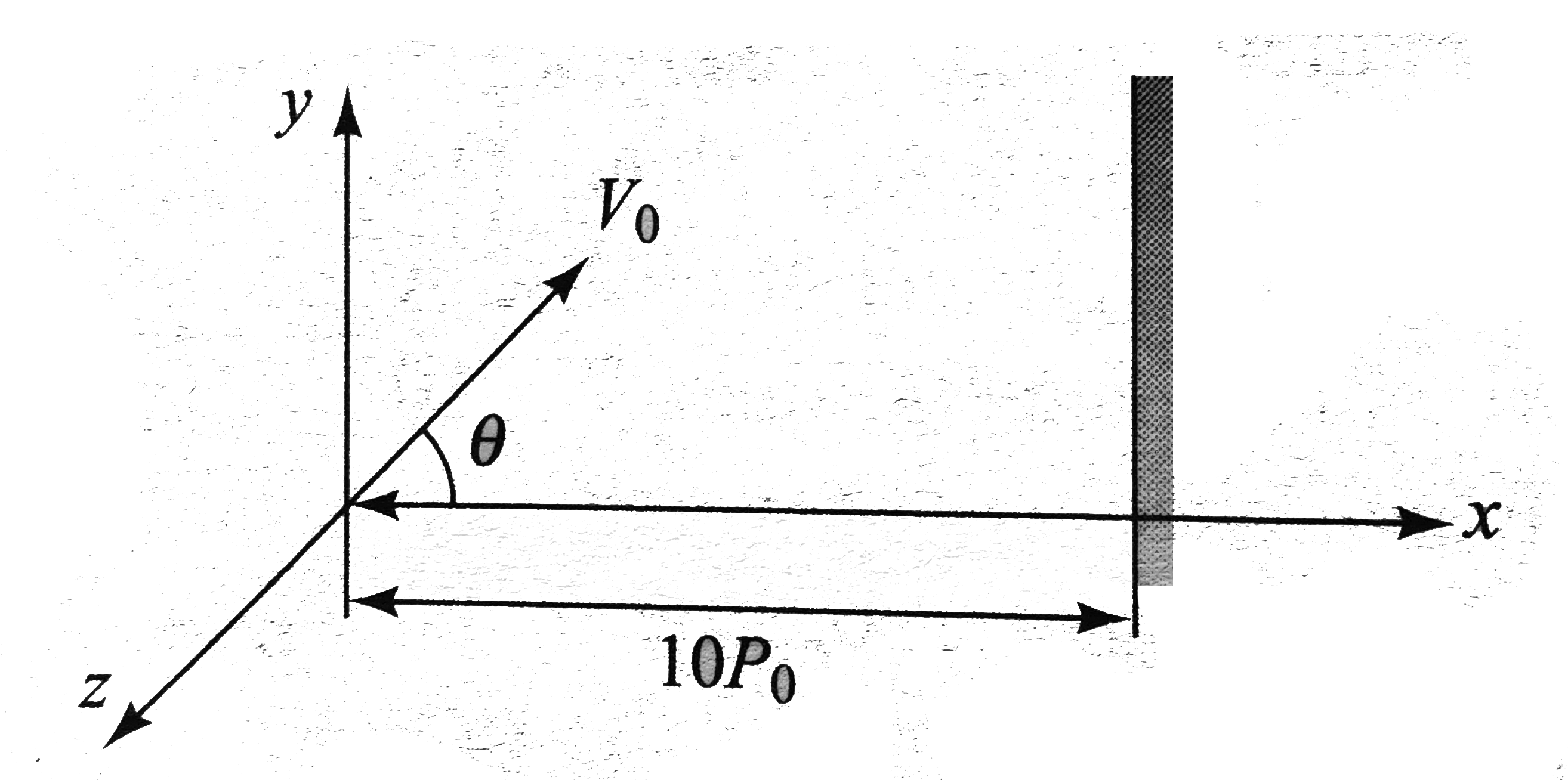 02:38View Solution
02:38View SolutionA uniform magnetic field of 1.5T exists in a cylindrical region of radius 10.0 cm, its direction being parallel to the axis along east to west. A current carrying wire in north-south direction passes through this region. The wire intersects the axis and experience a force of 1.2N downwards. If the wire is turned from north south to northest-southwest direction. then magnitude and direction of force is
04:46View SolutionAn insulating rod of length I carries a charge q distrubuted uniformly on it. The rod is pivoted at its mid-point and is rotated at a frequency f about a fixed axis perpendicular to the the rod and passing through the pivot . The magnetic moment of the rod system is
03:56View SolutionTwo straight segments of wire ab and bc each carrying current I, are placed as shown in fig. The cube edge is 50 cm and magnetic field is uniform along y-axis having magnitude 0.4T
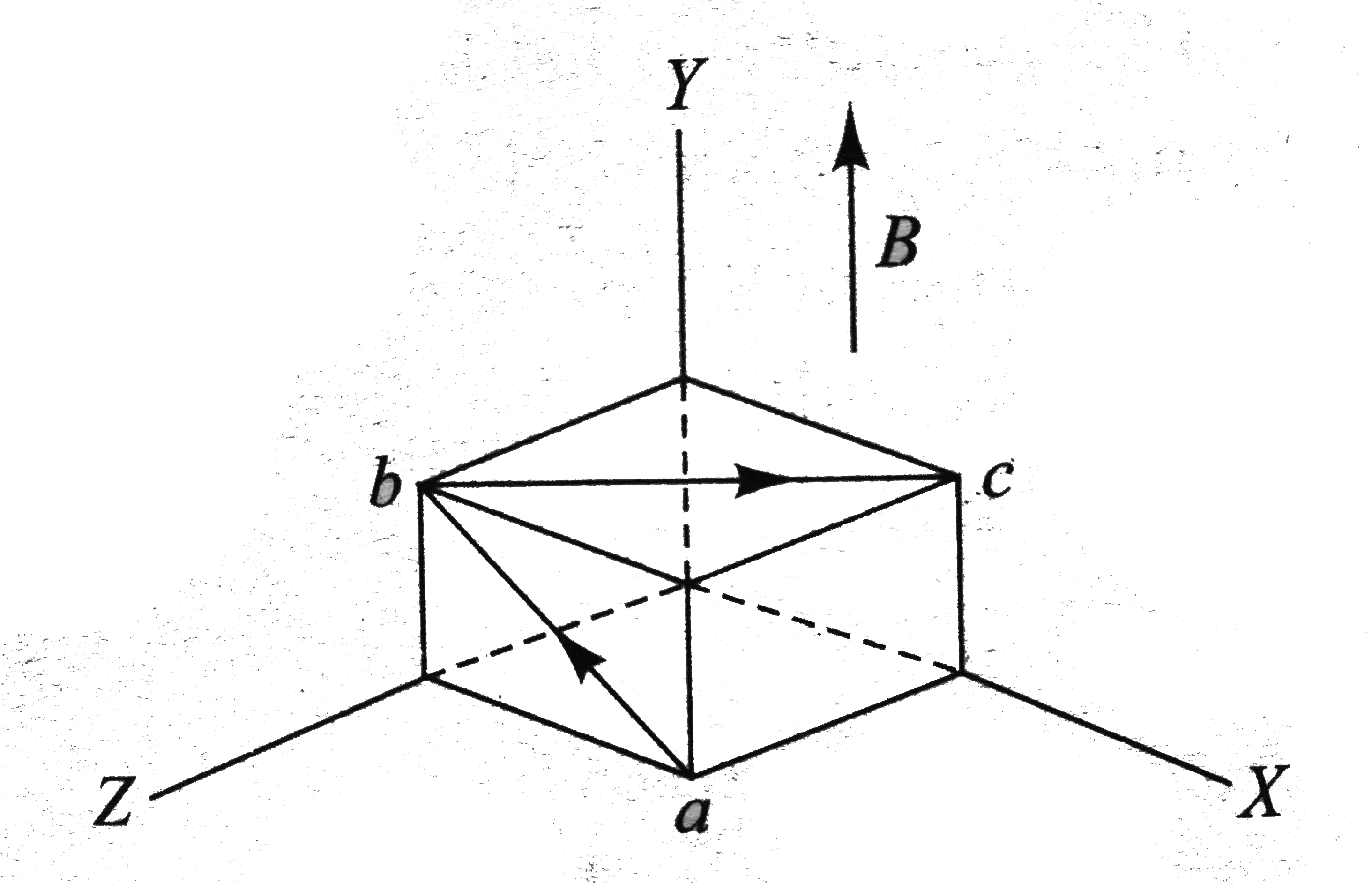 04:14View Solution
04:14View SolutionA current carrying loop is placed in the non-uniform magnetic field whose variation in space is shown in fig. Direction of magnetic field is into the plane of paper. The magnetic of paper. The magnetic force experienced by the loop is
 01:29View Solution
01:29View SolutionA current carrying loop lies on a smooth horizontal plane. Then,
02:59View SolutionA semicircular wire of radius R, carrying current I, is placed in a magnetic field as shown in Fig. On left side of X'X, magnetic field strangth `2B_0`. Both fields are directed inside the page. The magnetic force experienced by the wire would be
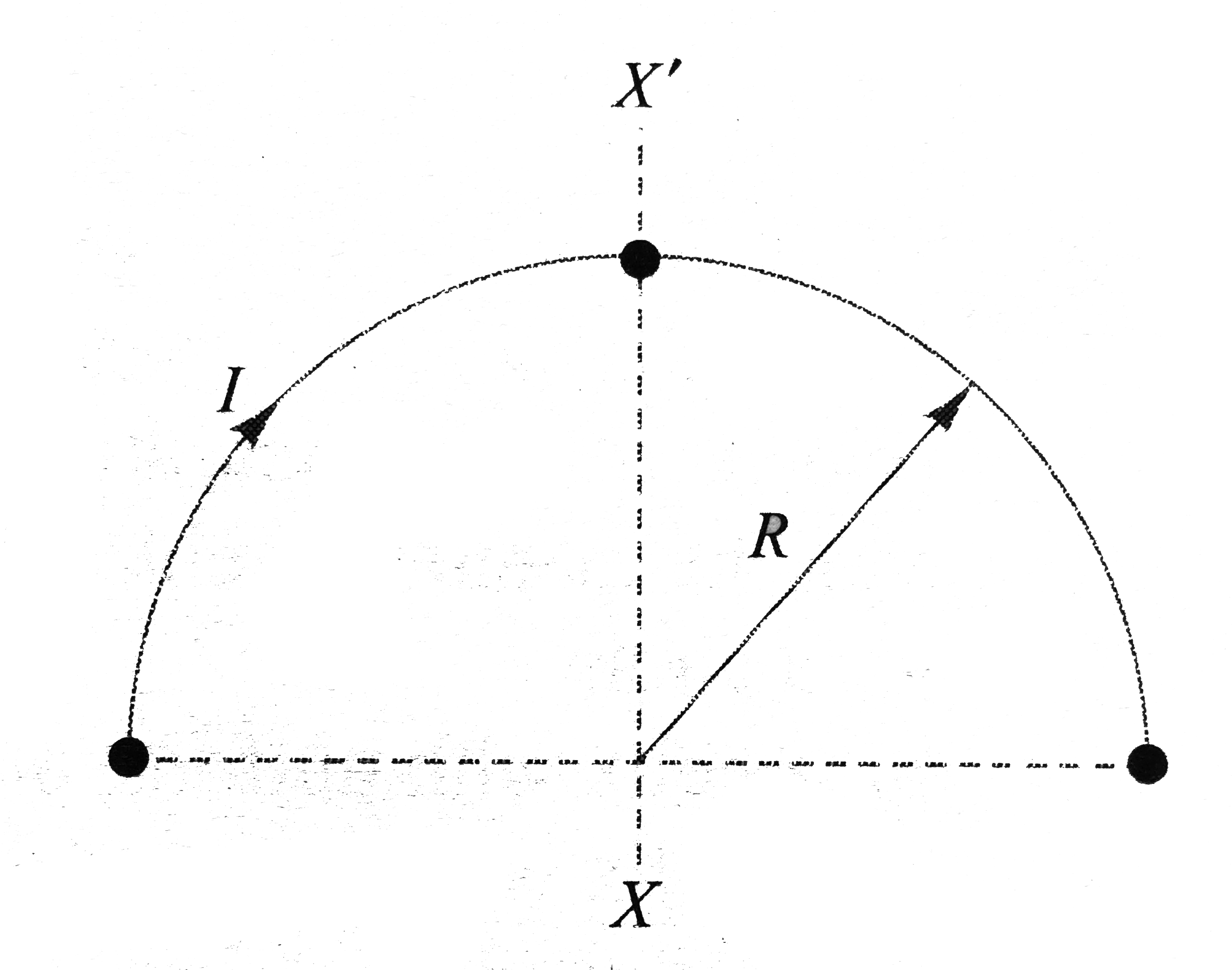 03:41View Solution
03:41View SolutionA wire of cross-sectional area A forms three sides of a square and is free to rotate about axis OO'. If the structure is deflected by an angle `theta` from the vertical when current i is passed through it in a magnetic field B acting vertically upward and density of the wire is `rho`, then the value of `theta` is given by
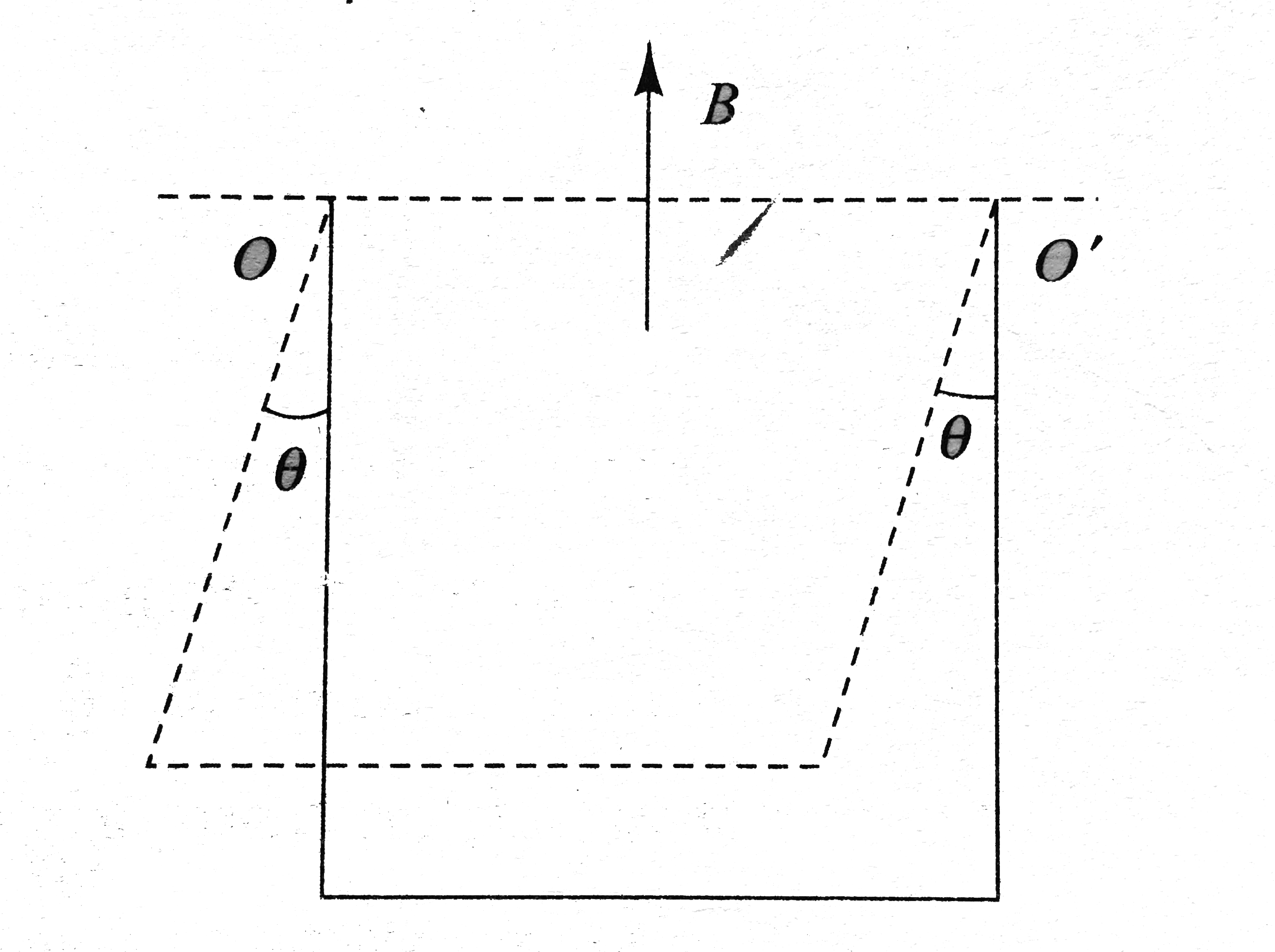 05:30View Solution
05:30View SolutionA proton of mass `1.67xx10^(-27)kg` and charge `1.6xx10^(-19)c` is projected with a speed of `2xx10^(6)m//s` at an angle of `60^(@)` to the x-axis. If a uniform magnetic field of `0.104` Tesla is applied along Y-axis, the path of proton is
04:00View SolutionA beam of mixture of `alpha` particle and protons are accelerted through same potential difference before entering into the magnetic field of strength B. if `r_1=5` cm then `r_2` is
 02:28View Solution
02:28View SolutionAn electron is projected at an angle `theta` with a uniform magnetic field. If the pitch of the helical path is equal to its radius, then the angle of projection is
01:22View SolutionA charged particle moves in a uniform magnetic field perpendicular to it, with a radius of curvature 4 cm. On passing through a metallic sheet it loses half of its kinetic energy. Then, the radius of curvature of the particle is
02:30View SolutionA particle of specific charge `alpha` is projected from origin with velocity `v=v_0hati-v_0hatk` in a uniform magnetic field `B=-B_0hatk`. Find time dependence of velocity and position of the particle.
10:45View SolutionA straight peice of conducting wire with mass M and length L is placed on a frictionless incline tilited at an angle `theta` from the horizontal (as shown in fig) There is a uniform. Vertical magnetic field at all points (produced by an arrangement of magnets not shown in fig. To keep the wire from sliding down the incline, a voltage source is

attached to the ends of the wire. When just the right amount of current flows through the wire, the wire remains at rest. Determine the magnitude and direction of the current in the wire that will cause the wire to remain at rest.04:04View SolutionIn a moving coil galvanometer is based on the
00:38View SolutionIn a moving coil galvanometer, we use a radial magnetic field so that the galvanometer scale is
00:46View SolutionThe current that must flow through the coil of a galvanometre so as to produce a deflection of one division on its scale is called
01:06View SolutionIn a moving coil galvanometer, the deflection of the coil `theta` is related to the electric current i by the relation
00:50View Solution
Exercises Single Correct questions and complete solutions for chapter MAGNETIC FIELD AND MAGNETIC FORCES of CENGAGE PHYSICS (HINGLISH) of Class 12
All Exercises from CENGAGE PHYSICS Class 12 PHYSICS MAGNETIC FIELD AND MAGNETIC FORCES
- Archives Assertion-reasion
- Archives Comprehension
- Archives Fill In The Blank
- Archives Integer
- Archives Multiple Correct
- Archives Single Correct
- Archives True /false
- Comphension Based
- Comprehension type
- Exercise 1.1
- Exercise 1.2
- Exercise1.3
- Exercises Assertion -reasoning
- Exercises Integer
- Exercises Linked Comprehension
- Exercises Multiple Correct
- Exercises Single Correct
- Exercises Subjective
- Illustration
- Multiple
- Multiple Correct Answer type
- Single Correct Answer Type
- Solved Example
- Subjective
- Subjective type
